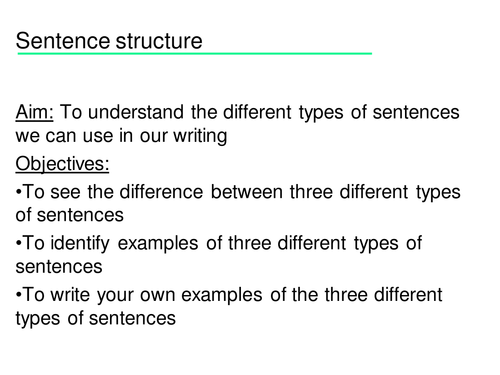



This lesson looks at the different types of sentences students can use in their writing, the lesson aims to give students the understanding of each sentences construction, and in turn enhance their written skills and variation of sentences they can use correctly.
1) Lesson aims and objectives:
Aim: To understand the different types of sentences we can use in our writing
Objectives:
To see the difference between three different types of sentences
To identify examples of three different types of sentences
To write your own examples of the three different types of sentences
2) Slide displays three sentences (one simple, compound and complex) and students are asked to discuss/make notes (up to you) on what differences they can pick out between the three. Hopefully students will note the length, use of connective words, punctuation etc. If they do not, the teacher can try to prompt these answers.
3) An explanation for each of the three sentences is displayed alongside the previous sentences, so students can make links with the descriptions and the examples. This will likely require more explanation and possible more examples.
4) Further examples shown to further enhance understanding and provide further discussion points. At this stage I usually ask students to write their own examples of each sentence to begin practising, and have them feed their ideas back. But this can be adapted dependant on your group/level.
5) Activity: Students given a short extract about The Men In Black (print out available in this resource) and asked to label the different sentences- instructions given on the print out and the presentation.
6) Answers to the task shown on the presentation.
7) Recap task - requires coloured response cards- six sentences displayed on the presentation, one at a time, and students to hold up the relevant response card. Instructions and answers displayed on the presentation.
8) Extension task included- sentences for students to identify as simple, compound or complex.
1) Lesson aims and objectives:
Aim: To understand the different types of sentences we can use in our writing
Objectives:
To see the difference between three different types of sentences
To identify examples of three different types of sentences
To write your own examples of the three different types of sentences
2) Slide displays three sentences (one simple, compound and complex) and students are asked to discuss/make notes (up to you) on what differences they can pick out between the three. Hopefully students will note the length, use of connective words, punctuation etc. If they do not, the teacher can try to prompt these answers.
3) An explanation for each of the three sentences is displayed alongside the previous sentences, so students can make links with the descriptions and the examples. This will likely require more explanation and possible more examples.
4) Further examples shown to further enhance understanding and provide further discussion points. At this stage I usually ask students to write their own examples of each sentence to begin practising, and have them feed their ideas back. But this can be adapted dependant on your group/level.
5) Activity: Students given a short extract about The Men In Black (print out available in this resource) and asked to label the different sentences- instructions given on the print out and the presentation.
6) Answers to the task shown on the presentation.
7) Recap task - requires coloured response cards- six sentences displayed on the presentation, one at a time, and students to hold up the relevant response card. Instructions and answers displayed on the presentation.
8) Extension task included- sentences for students to identify as simple, compound or complex.
Something went wrong, please try again later.
This resource hasn't been reviewed yet
To ensure quality for our reviews, only customers who have purchased this resource can review it
Report this resourceto let us know if it violates our terms and conditions.
Our customer service team will review your report and will be in touch.
£3.50
